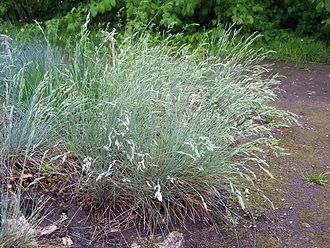Graminoid




Graminoids are a group of herbaceous plants in the Poaceae (true grasses), Cyperaceae (sedges), and Juncaceae (rushes) families. These plants are characterized by their narrow leaves and stem structure. Graminoids are significant in various ecosystems, including grasslands, wetlands, and savannas, playing crucial roles in the ecology of these habitats. They are also of immense importance to humans, providing food, fodder, and raw materials for construction and manufacturing.
Characteristics[edit]
Graminoids share several key characteristics, although there are variations among species and families. They typically have slender, linear leaves and grow from the base, a feature that allows them to recover from grazing and mowing. Their stems are usually hollow in grasses and rushes but solid in sedges. The flowers of graminoids are often small and inconspicuous, adapted for wind pollination. These plants reproduce both sexually through seeds and asexually through rhizomes or stolons.
Classification[edit]
Graminoids are classified into three main families:
- Poaceae (true grasses): This is the largest family of graminoids, encompassing a wide range of species, including economically important crops such as wheat, rice, corn, and sugarcane. Grasses are characterized by their jointed stems and sheathed leaves.
- Cyperaceae (sedges): Sedges can be distinguished from grasses by their solid, triangular stems and leaves that are arranged in three ranks. They are commonly found in wet habitats but can grow in a variety of environments.
- Juncaceae (rushes): Rushes resemble grasses and sedges but have solid, cylindrical stems. They typically grow in moist or aquatic environments.
Ecological Importance[edit]
Graminoids play vital roles in their ecosystems. They act as primary producers, converting sunlight into energy through photosynthesis and forming the base of the food chain. Their dense root systems help prevent soil erosion and promote water filtration. Graminoids also provide habitat and food for a wide range of wildlife, including birds, insects, and mammals.
Human Uses[edit]
Humans have cultivated graminoids for thousands of years. Cereal grains from grasses such as wheat, rice, and corn are a staple food source for a large portion of the world's population. Sedges and rushes have been used for making mats, baskets, and other handicrafts. Additionally, graminoids are used in landscaping and soil stabilization projects.
Conservation[edit]
While many graminoid species are abundant and widespread, some are under threat from habitat loss, pollution, and climate change. Conservation efforts are important to protect these species and the ecosystems they support. This includes preserving natural habitats, restoring degraded areas, and researching sustainable agricultural practices.
Ad. Transform your life with W8MD's Budget GLP-1 injections from $75


W8MD offers a medical weight loss program to lose weight in Philadelphia. Our physician-supervised medical weight loss provides:
- Weight loss injections in NYC (generic and brand names):
- Zepbound / Mounjaro, Wegovy / Ozempic, Saxenda
- Most insurances accepted or discounted self-pay rates. We will obtain insurance prior authorizations if needed.
- Generic GLP1 weight loss injections from $75 for the starting dose.
- Also offer prescription weight loss medications including Phentermine, Qsymia, Diethylpropion, Contrave etc.
NYC weight loss doctor appointmentsNYC weight loss doctor appointments
Start your NYC weight loss journey today at our NYC medical weight loss and Philadelphia medical weight loss clinics.
- Call 718-946-5500 to lose weight in NYC or for medical weight loss in Philadelphia 215-676-2334.
- Tags:NYC medical weight loss, Philadelphia lose weight Zepbound NYC, Budget GLP1 weight loss injections, Wegovy Philadelphia, Wegovy NYC, Philadelphia medical weight loss, Brookly weight loss and Wegovy NYC
|
WikiMD's Wellness Encyclopedia |
| Let Food Be Thy Medicine Medicine Thy Food - Hippocrates |
Medical Disclaimer: WikiMD is not a substitute for professional medical advice. The information on WikiMD is provided as an information resource only, may be incorrect, outdated or misleading, and is not to be used or relied on for any diagnostic or treatment purposes. Please consult your health care provider before making any healthcare decisions or for guidance about a specific medical condition. WikiMD expressly disclaims responsibility, and shall have no liability, for any damages, loss, injury, or liability whatsoever suffered as a result of your reliance on the information contained in this site. By visiting this site you agree to the foregoing terms and conditions, which may from time to time be changed or supplemented by WikiMD. If you do not agree to the foregoing terms and conditions, you should not enter or use this site. See full disclaimer.
Credits:Most images are courtesy of Wikimedia commons, and templates, categories Wikipedia, licensed under CC BY SA or similar.
Translate this page: - East Asian
中文,
日本,
한국어,
South Asian
हिन्दी,
தமிழ்,
తెలుగు,
Urdu,
ಕನ್ನಡ,
Southeast Asian
Indonesian,
Vietnamese,
Thai,
မြန်မာဘာသာ,
বাংলা
European
español,
Deutsch,
français,
Greek,
português do Brasil,
polski,
română,
русский,
Nederlands,
norsk,
svenska,
suomi,
Italian
Middle Eastern & African
عربى,
Turkish,
Persian,
Hebrew,
Afrikaans,
isiZulu,
Kiswahili,
Other
Bulgarian,
Hungarian,
Czech,
Swedish,
മലയാളം,
मराठी,
ਪੰਜਾਬੀ,
ગુજરાતી,
Portuguese,
Ukrainian
